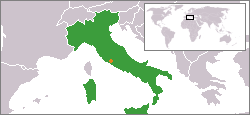Holy See–Italy relations: Difference between revisions
Tags: Mobile edit Mobile web edit |
No edit summary Tags: Mobile edit Mobile web edit |
||
| Line 11: | Line 11: | ||
== Diplomatic Legations to the Vatican in Italy == |
== Diplomatic Legations to the Vatican in Italy == |
||
Due to the size of the [[Vatican City]] State, embassies accredited to the Holy See are based in Italy. Embassy officials of other countries Treaties signed between [[Italy]] and the Vatican City State permit such embassages. The Embassy of Italy to the Holy See is unique amongst foreign embassages in that it is the only embassy based on its home territory. |
Due to the size of the [[Vatican City]] State, embassies accredited to the Holy See are based in Italy. Embassy officials of other countries also stay in Italy. Treaties signed between [[Italy]] and the Vatican City State permit such embassages. The Embassy of Italy to the Holy See is unique amongst foreign embassages in that it is the only embassy based on its home territory. |
||
The Holy See maintains formal diplomatic relations with 176 sovereign states, the [[European Union]], and the [[Order of Malta]]; 69 of the diplomatic missions accredited to the Holy See are situated in [[Rome]], though those countries then have two embassies in the same city, since, by agreement between the Holy See and Italy, the same person cannot be accredited simultaneously to both. |
The Holy See maintains formal diplomatic relations with 176 sovereign states, the [[European Union]], and the [[Order of Malta]]; 69 of the diplomatic missions accredited to the Holy See are situated in [[Rome]], though those countries then have two embassies in the same city, since, by agreement between the Holy See and Italy, the same person cannot be accredited simultaneously to both. |
||
Revision as of 14:40, 10 June 2023
 | |
Italien |
Holy See |
|---|---|
Holy See–Italy relations refers to the special relationship between the Holy See, which is sovereign over the Vatican City, and the Italian Republic.
History
Relations with the Kingdom of Italy were difficult during the papacies of Pius IX and Leo XIII, who had to endure the status of prisoner of the Vatican after the capture of Rome,[1] refusing to recognize the Law of Guarantees.[2] Leo XIII forbade Christians from participating in elections and accused the Italian state of being controlled by freemasons.[citation needed]
It was only under Pius XI that the Lateran Treaty was signed, establishing the State of Vatican City, allowing for greater papal autonomy.[3]
The new Italian Republic established in 1946 recognized freedom of religion. However, under Pius XII and Paul VI, the Christian Democrats thrived and had great influence on Italian politics, in order to stop the Italian Communist Party from gaining power.[4]
Diplomatic Legations to the Vatican in Italy
Due to the size of the Vatican City State, embassies accredited to the Holy See are based in Italy. Embassy officials of other countries also stay in Italy. Treaties signed between Italy and the Vatican City State permit such embassages. The Embassy of Italy to the Holy See is unique amongst foreign embassages in that it is the only embassy based on its home territory.
The Holy See maintains formal diplomatic relations with 176 sovereign states, the European Union, and the Order of Malta; 69 of the diplomatic missions accredited to the Holy See are situated in Rome, though those countries then have two embassies in the same city, since, by agreement between the Holy See and Italy, the same person cannot be accredited simultaneously to both.
This is shown clearly by the fact that Italy recognizes the People's Republic of China represents China and as such, the PRC Embassy to Italy is in Rome. However, the Vatican City State recognizes the Republic of China (which controls Taiwan) represents China, and as such, the ROC Embassy to the Holy See is also in Rome.
See also
- Apostolic Nunciature to Italy
- Lateran Treaty
- List of diplomatic missions in Italy
- List of diplomatic missions of Italy
- Index of Vatican City-related articles
- Holy See–European Union relations
Notes and references
- ^ Updike, Robin (2005-01-09). ""Prisoner of the Vatican": A pope's last stand and the birth of the new Italy". seattletimes.com. The Seattle Times. Retrieved 2021-11-06.
- ^ "Law of Guarantees". newadvent.org. Retrieved 2021-11-06.
- ^ "The Lateran Treaty". Vatican.com. 2018-05-17. Retrieved 2021-11-06.
- ^ Caimmi, Michele (2020-07-25). "When the Pope Excommunicated the Communists". historyofyesterday.com. Retrieved 2021-11-06.

